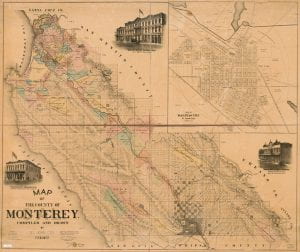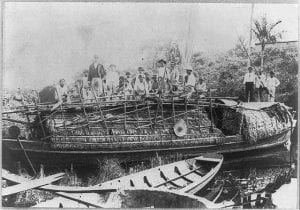How do I effectively use primary sources to engage my diverse students in historical inquiry and thinking? How do I integrate the environment and environmental literacy into my curricula?
In the summer of 2019, 22 teachers joined us in a four-day workshop, sponsored by the Library of Congress Teaching with Primary Sources Program and the CA Education and the Environment Initiative, to grapple with these questions. The week was jam-packed with activities, including a model lesson investigating the causes of the Dust Bowl through primary and secondary sources, presentations regarding the history of the Amah Mutsun Tribal Band and the shrinking Aral Sea; and a guided tour of the Cowell Lime Works Historic District. Threaded throughout these activities were the themes of place-based historic inquiry and human-environment interactions, and lots of rich discussion and sharing of ideas and tools.
That sounds like plenty for four days, yes? Well we haven’t even listed all that we did, but there was also a focus task that drove our work for the week. That task was supporting participants in developing a lesson that used some of these sources and ideas to effectively engage all students, including English learners, in rich historical discussion and inquiry.
Teachers explored the Library of Congress’ rich digitized collections of historical sources and found sources to use in a lesson for their own classroom that integrated one of California’s environmental principles and concepts. Being the professionals that they are, participants pulled this off much to our delight. For example, elementary teachers used some of the ideas from the session on using google maps to have students compare a historic map of their community’s region with a contemporary representation of the same. Similarly, a U.S. History teacher had students investigate how late 19th century industrialism and urban growth played out in their local community, asking “How can the themes of Industrialism and Urban Growth unit be “seen” in the physical environment of Santa Cruz, both then and now?”
A World History teacher planned to engage her students in analyzing and contextualizing resource and land-use conflict in the Amazon Rainforest and another teacher developed an investigation into the causes of the 2003 U.S. Invasion of Iraq. Good stuff!
This was our first multi-day summer workshop and we loved that it allowed us to spend extended time exploring new content, tools, and pedagogies with the excellent educators who joined us. But we also learned some lessons that will help us refine and improve future workshops. Those lessons also reaffirmed some of what we know and believe here at HCP—building collaborations and communities across areas of expertise and practice makes for powerful intellectual and learning opportunities! (Our group included UC Santa Cruz history and education faculty, classroom teachers and teacher-leaders, and local historians and representatives.)
NOTES: Please see





